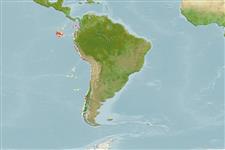Klassifizierung / Names
Namen | Synonyme | Catalog of Fishes(Gattung, Arten) | ITIS | CoL | WoRMS | Cloffa
Holocephali (Chimären, Seekatzen) (chimaeras) >
Chimaeriformes (Chimaeras) >
Chimaeridae (Shortnose chimaeras or ratfishes)
Etymology: Hydrolagus: hydro-, combining form of hydor (Gr.), water; lagos (Gr.), hare, i.e., “water rabbit,” probably referring to three pairs of tooth plates, which tend to protrude from the mouth like a rabbit’s incisors. (See ETYFish); alphus: Greek for a white spot on the skin, referring to noticeable white spot on sides. (See ETYFish).
Environment: milieu / climate zone / depth range / distribution range
Ökologie
seewasser bathydemersal; tiefenbereich 600 - 900 m (Ref. 57721). Tropical
Verbreitung
Länder | FAO Gebiete | Ecosystems | Vorkommen | Point map | Einführungen | Faunafri
Eastern Central Pacific: Galapagos Islands.
Size / Gewicht / Alter
Maturity: Lm ? range ? - ? cm
Max length : 41.9 cm TL Männchen/unbestimmt; (Ref. 57721); 48.0 cm TL (female)
Kurzbeschreibung
Morphologie | Morphometrie
Assigned to the genus Hydrolagus based upon the absence of an anal fin. Hydrolagus alphus is distinguished by being medium in size (average PCL 321 mm) and uniform dark brown in color with a distinct white spot (4%-6% BDL) on the lateral side above the pectoral fins. Paired fins with bluish hue and white margins. The dorsal spine longer than triangular shaped first dorsal fin and extends beyond the origin of the second dorsal fin when depressed. Eyes large (40.8–44.5% HDL) and pectoral fins reaching to or beyond insertion of pelvic fins when depressed. Pelvic claspers small, not extending beyond distal edge of pelvic fin, and divided distally for one half their length with slender fleshy denticulate tips. The base of second dorsal fin is long, deeply depressed and light colored in the center, anterior and posterior regions dark, considerably greater in height than the white middle region (Ref. 57721).
Life cycle and mating behavior
Geschlechtsreife | Fortpflanzung | Ablaichen | Eier | Fecundity | Larven
Quaranta, K.L., D.A. Didier, D.J. Long and D.A. Ebert, 2006. A new species of chimaeroid, Hydrolagus alphus sp. nov.(Chimaeriformes: Chimaeridae) from the Galapagos Islands. Zootaxa 1377:33-45. (Ref. 57721)
IUCN Rote Liste Status (Ref. 130435)
Bedrohung für Menschen
Harmless
Nutzung durch Menschen
Mehr Information
LänderFAO GebieteEcosystemsVorkommenEinführungenStocksÖkologieNahrungNahrungsorganismenNahrungsaufnahmeNahrungsmenge
NamenSynonymeMetabolismusRäuberÖkotoxikologieFortpflanzungGeschlechtsreifeAblaichenSpawning aggregationFecundityEierEientwicklung
Alter/GrößeWachstumLänge-GewichtLänge-LängeLängenhäufigkeitenMorphometrieMorphologieLarvenLarven Pop.Dyn.RekrutierungDichteBRUVS
ReferenzenAquakulturAquakultur ProfilZuchtlinienGenetikElectrophoresesVererbbarkeitKrankheitenVerarbeitungNutrientsMass conversion
PartnerBilderStamps, Coins Misc.LauteCiguateraGeschwindigkeitSchwimmstilKiemenoberflächeOtolithsGehirngrößeSehfähigkeit
Tools
Zusatzinformationen
Download XML
Internet Quellen
Estimates based on models
Preferred temperature (Ref.
123201): 3.7 - 7, mean 5.7 °C (based on 7 cells).
Phylogenetic diversity index (Ref.
82804): PD
50 = 0.5000 [Uniqueness, from 0.5 = low to 2.0 = high].
Bayesian length-weight: a=0.00282 (0.00118 - 0.00673), b=3.10 (2.89 - 3.31), in cm total length, based on LWR estimates for this (Sub)family-body shape (Ref.
93245).
Trophic level (Ref.
69278): 3.7 ±0.6 se; based on size and trophs of closest relatives
Widerstandsfähigkeit (Ref.
120179): niedrig, Verdopplung der Population dauert 4,5 - 14 Jahre. (Deep-water species, few large eggs.).
Fishing Vulnerability (Ref.
59153): Moderate vulnerability (38 of 100).
